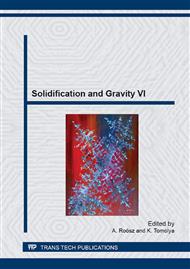[1]
N.N. Aleksandrov, B.S. Mil'man, N.G. Osada, L.V. Il'icheva, V.V. Andreev, Crystallization and structure of vermicular graphite in cast iron, Russian casting production, 9 (1975) 365-366.
Google Scholar
[2]
G.X. Sun, C.R. Loper, Graphite flotation in cast iron, AFS Trans. 91 (1983) 841-854.
Google Scholar
[3]
W.C. Johnson, H.B. Smartt, The role of interphase boundary adsorption in the formation of spheroidal graphite in cast iron, Metall. Trans 8A (1977) 553-565.
DOI: 10.1007/bf02676976
Google Scholar
[4]
K. Theuwissen, M. -C. Lafont, L. Laffont, B. Viguier, J. Lacaze, Microstructural chara-cterization of graphite spheroids in ductile iron, Trans. Indian Inst. Met. 65 (2012) 627-631.
DOI: 10.1007/s12666-012-0162-5
Google Scholar
[5]
D.D. Double, A. Hellawell, The nucleation and growth of graphite. The modification of cast iron, Acta Metall. Mater. 43 (1995) 2435-2442.
DOI: 10.1016/0956-7151(94)00416-1
Google Scholar
[6]
K. Theuwissen, J. Lacaze, L. Laffont, J. Zollinger, D. Daloz, Effect of Ce and Sb on Primary Graphite Growth in Cast Irons, Trans. Indian Inst. Met. 65 (2012) 707-712.
DOI: 10.1007/s12666-012-0203-0
Google Scholar
[7]
G. Lesoult M. Castro, J. Lacaze, Solidification of spheroidal graphite cast iron. Part I : physical modelling, Acta materialia 46 (1998) 983-995.
DOI: 10.1016/s1359-6454(97)00281-4
Google Scholar
[8]
J. Lacaze, G. Lesoult, M. Castro, Solidification of spheroidal graphite cast iron. Part II: numerical simulation, Acta materialia 46 (1998) 997-1010.
DOI: 10.1016/s1359-6454(97)00282-6
Google Scholar
[9]
R. Mitsche, G. Haensel, K. Maurer, H. Schäffer, Recherches, par examen au microscope électronique notamment, sur les formes dégénérées du graphite dans les fontes G.S., Fonderie 270 (1968) 367-382.
Google Scholar
[10]
M. Hillert, Some theoretical considerations in nucleation and growth during solidification of graphitic and white cast irons, in: H.D. Merchant (Ed. ), Recent research on cast iron, Gordon and Breach, New-York, 1968, pp.101-127.
Google Scholar
[11]
R.H. McSwain, C.E. Bates, W.D. Scott, Iron-graphite surface phenomena and their effects on iron solidification, AFS Trans. 82 (1974) 85-94.
Google Scholar
[12]
S. Amini, R. Abbaschian, Nucleation and growth kinetics of grapheme layers from a molten phase, Carbon 51 (2013) 110-123.
DOI: 10.1016/j.carbon.2012.08.019
Google Scholar
[13]
G.R. Lesoult, Recherche sur la théorie de la solidification eutectique dirigée, Thèse de doctorat d'Etat, Institut National Polytechnique de Lorraine, France, (1976).
Google Scholar
[14]
H. Fredriksson, S. Wetterfall, A study of transition from undercooled to flake graphite in cast iron, in: B. Lux, I. Minfoff, F. Mollard (Eds. ), The Metallurgy of Cast Iron, Georgi Pub. Comp., Saint-Saphorin, 1975, pp.277-293.
Google Scholar


